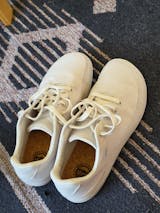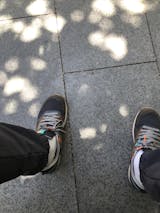Our feet work a lot harder than most of us realise or give them credit for. Right from carrying one’s entire bodyweight and taking thousands of steps in a day, to subjecting them to uncomfortable shoes while standing on them for several hours every day; they go through a lot which can lead to both unhealthy and unhygienic feet if not cared for appropriately.
Just like poor dental hygiene causes problems with your teeth, lack of foot hygiene and improper care leads to issues that include fungal infections, bad odour, calluses, and more. Considering the fact that your feet are an integral part of your physical capabilities (they are literally your body’s foundation), keeping them healthy, hygienic, and happy must be prioritised!
Maintaining good foot hygiene is fairly simple, however, it does require daily attention and more awareness surrounding the harmful habits that feet are subjected to on a day-to-day basis. With that in mind, let’s take a look at the top tips to improve your overall foot hygiene.
1. Clean Your Feet Properly
Pay a little more attention to your feet when you shower or bathe; a basic wash doesn’t always remove dirt and bacteria efficiently. Podiatrists advise scrubbing your feet with warm water and soap every day when shower, as well as right after you have potentially encountered germs from a public place (eg; walking barefoot in a public gym). You can use your bare hands to scrub your feet, or try a foot brush which is convenient to use and typically does a more thorough job at scrubbing away dirt.
2. Keep Your Feet Dry

Moisture and fungal infections go hand in hand. These harmful organisms thrive in wet/damp/moist areas which include your feet! This is why it is important to dry your feet thoroughly after they have encountered water. Be it after a shower, getting out of a swimming pool, taking a dip in the sea, and so on; make sure that there is a towel handy to dry your feet (between the toes as well) to prevent fungal organisms (if present) from multiplying.
3. Wear Breathable Shoes
For optimal foot health, minimalist or barefoot shoes are highly recommended. Above this, your footwear should be made from breathable material or simply designed in a manner that allows your feet to breathe more. This will keep foot sweat to a minimum while also ensuring that your feet dry up quickly. Mesh, canvas, and leather are all good options to consider when looking for breathable shoes. Of course, different occasions/purposes generally dictate the type of material that is appropriate to wear; for example, mesh is advised when exercising/running, canvas is great for a casual outing, and leather is best-suited for formal or semi-formal events.
4. Clip Your Toenails Correctly

Many individuals make the mistake of trimming their toenails (especially the big toenail) in a rounded shape. While it’s okay to curve or smoothen the corners of the nails, they should be clipped straight across and then filed around the edges without rounding them out too drastically. When toenails are cut too close to the skin or shaped in a way that the corners allow a part of the underskin to show, it increases the chances of ingrown toenails – something that is not only painful but can lead to serious infections as well.
5. Change Out of Sweaty Socks Immediately

Since both feet are home to 500,000 sweat glands collectively, it is no surprise that perspiration occurs fairly quickly when you put on socks and shoes. Playing sports, running, and exercising all lead to excessive sweating of the feet and often leave your socks damp, if not drenched. As we mentioned earlier, moisture is a breeding ground for germs and fungal organisms; therefore, it is very important to remove or change out your sweaty socks as soon as possible. Be sure to wash or dry your feet once the socks come off. An additional tip is to purchase synthetic socks as opposed to other materials like wool or cotton because the former material dries up faster.
6. Address Cracked Heels/Dry Skin
Cracks, peeling, and dry skin encourage the accumulation of dirt and bacteria because they have excellent places to hide. Where cracked heels and peeling of skin are concerned, they can generally be treated at home with the help of foot files, pumice stones, and other tools/products that are intended for DIY use. For severe cases, you can visit a pedicurist to deal with these types of foot issues. Dry skin, on the other hand, requires a gentle foot massage with any type of moisturiser or petroleum jelly. You should, however, avoid applying moisturiser between your toes as they tend to remain moist for too long which, in turn, runs the risk of infection.
7. Wear Shoes That Fit Your Feet Perfectly
The only shoes that will fit your feet the way they are supposed to are none other than barefoot/minimalist shoes! This is because they are designed as per the primal shape of the foot – meaning they are widest at the top so that your toes do not get crushed. Unlike modern or conventional footwear, you can purchase foot-healthy shoes that will fit perfectly, thereby sparing your feet the discomfort of tight shoes which can also lead to swelling. Moreover, minimalist shoes are extremely flexible (not hard or rigid) and therefore, minimise the development of calluses and corns. Check out some of the top barefoot brands on the market and do yourself and your feet a favour – make the switch from conventional shoes to minimalist footwear sooner than later!
While the tips above will help you maintain excellent foot hygiene, if you are experiencing foot problems that are either related or unrelated to foot hygiene, please consult your doctor or physician for the necessary course of treatment.
At bprimal, we work with shoemakers and brands who create natural footwear that are made to encourage better foot health by repairing the damage caused by long term use of modern shoes. These minimalist or healthy footwear alternatives ensure proper preservation of one’s natural foot shape and function thanks to their inclusion of all the design specifics needed to achieve optimal foot health. Some of these features include wide toe boxes, slim and flexible soles, and no heel elevation. Our involvement and interaction with people who create and promote products that help individuals fix their foot problems has also inspired us to spread crucial awareness – relating to prioritising foot health as told by the experts – via our blog. Learn More - check out bprimal educational articles here, and browse through the different brands and collections of natural footwear and foot health restoration products we carry.
DISCLAIMER:
The above content is for educational or informational purposes only and is not intended to replace or augment professional medical instruction, diagnosis, or treatment. Read the full Terms and Conditions & Disclaimer here.
























